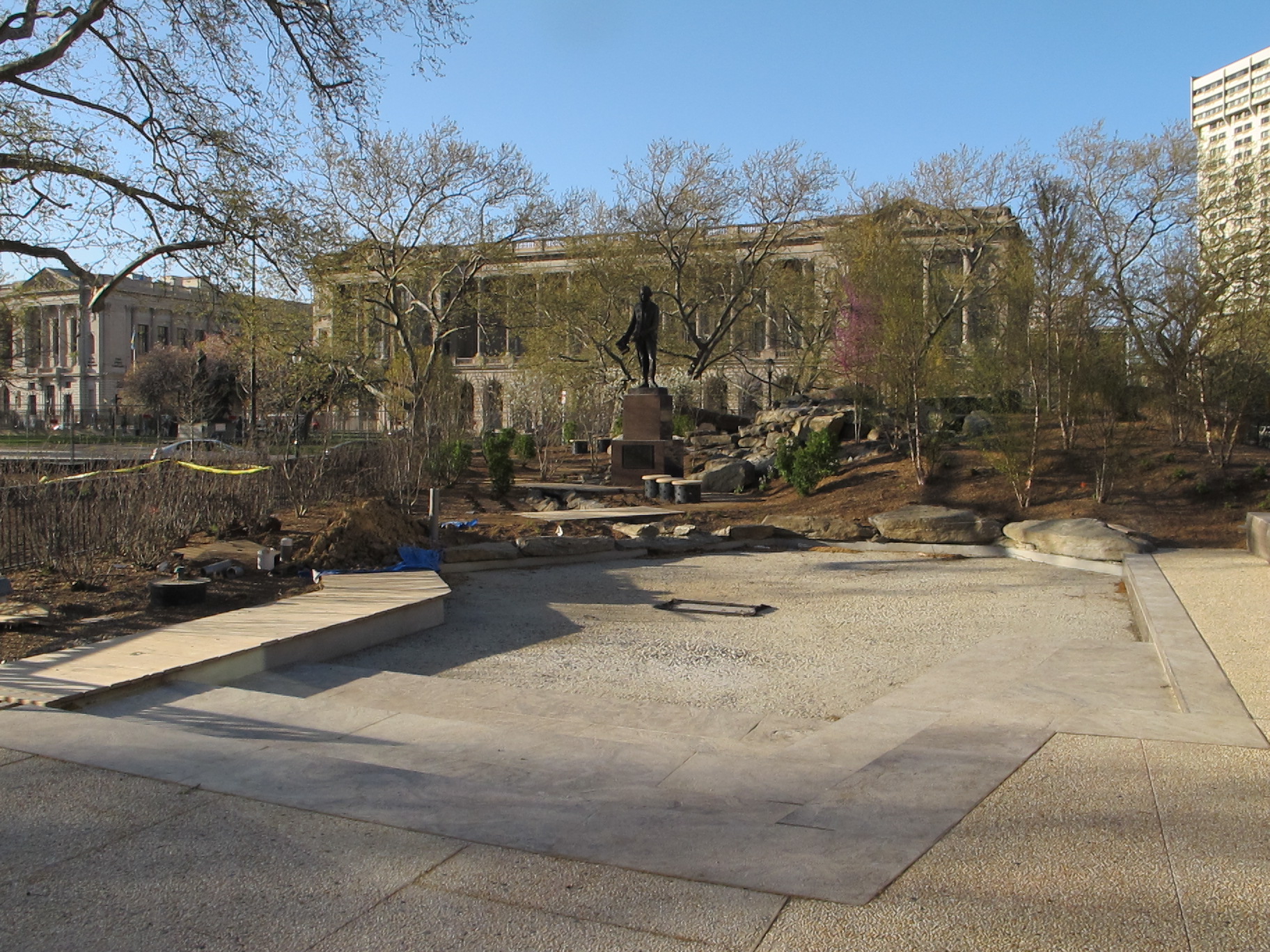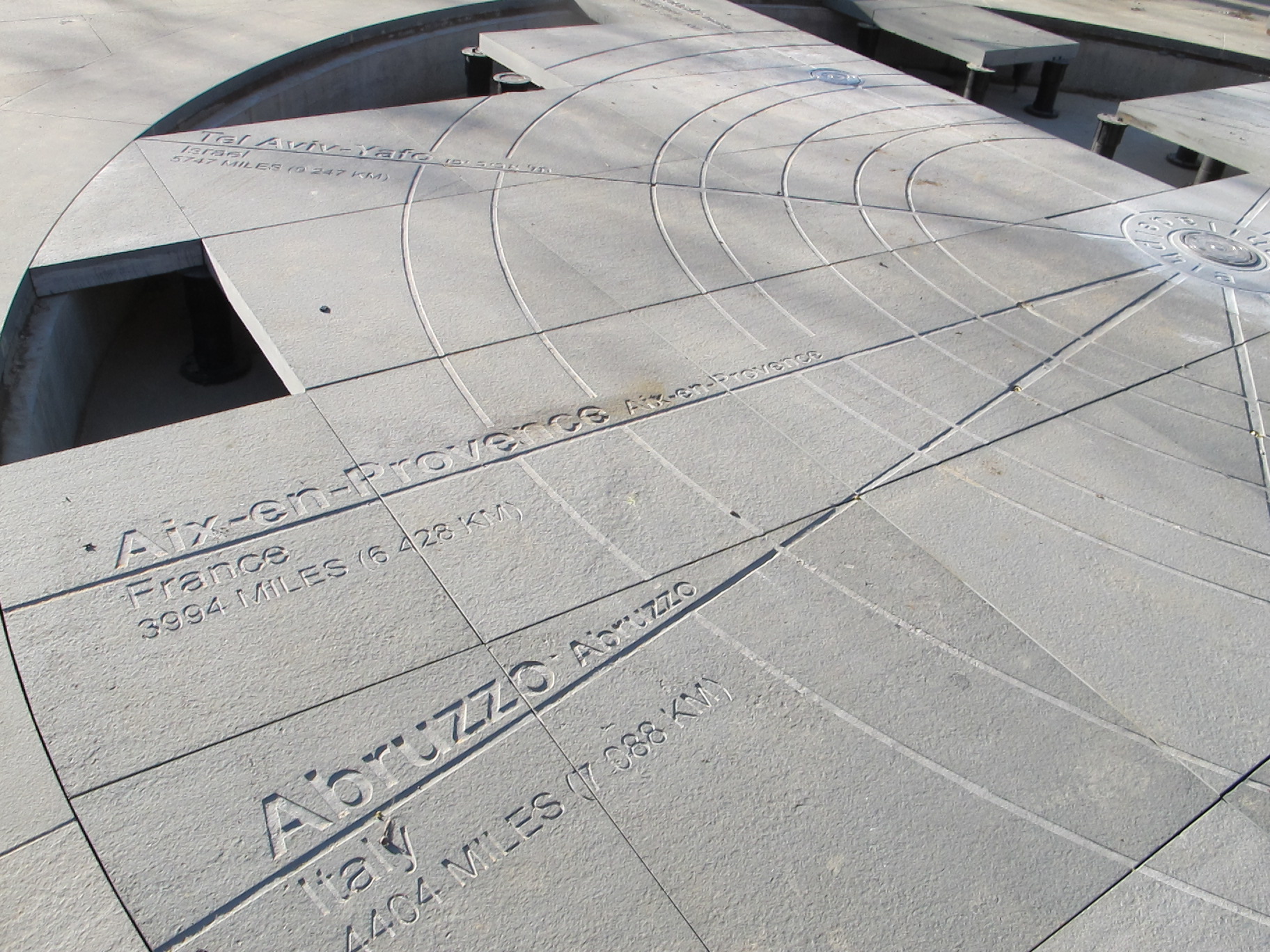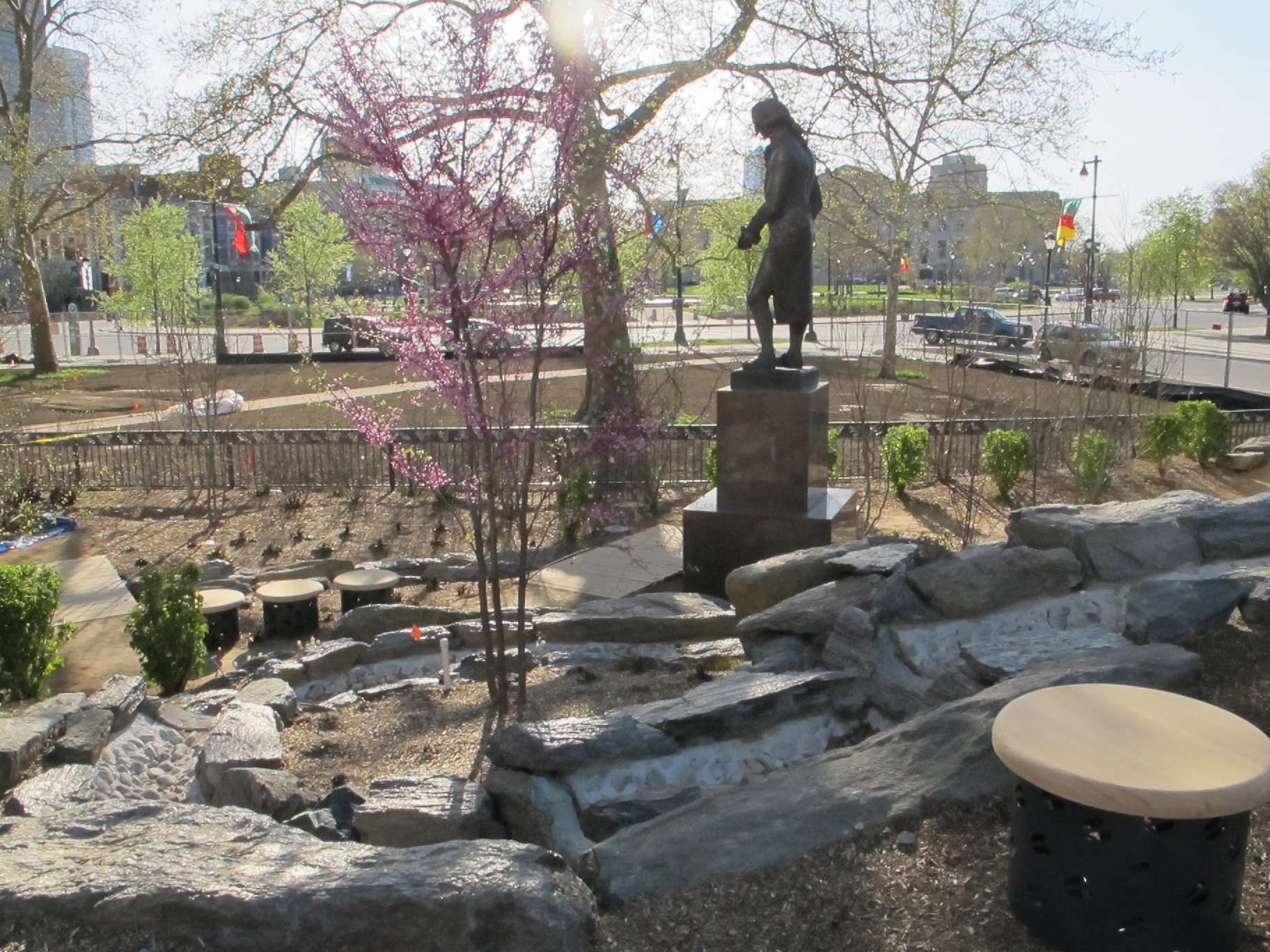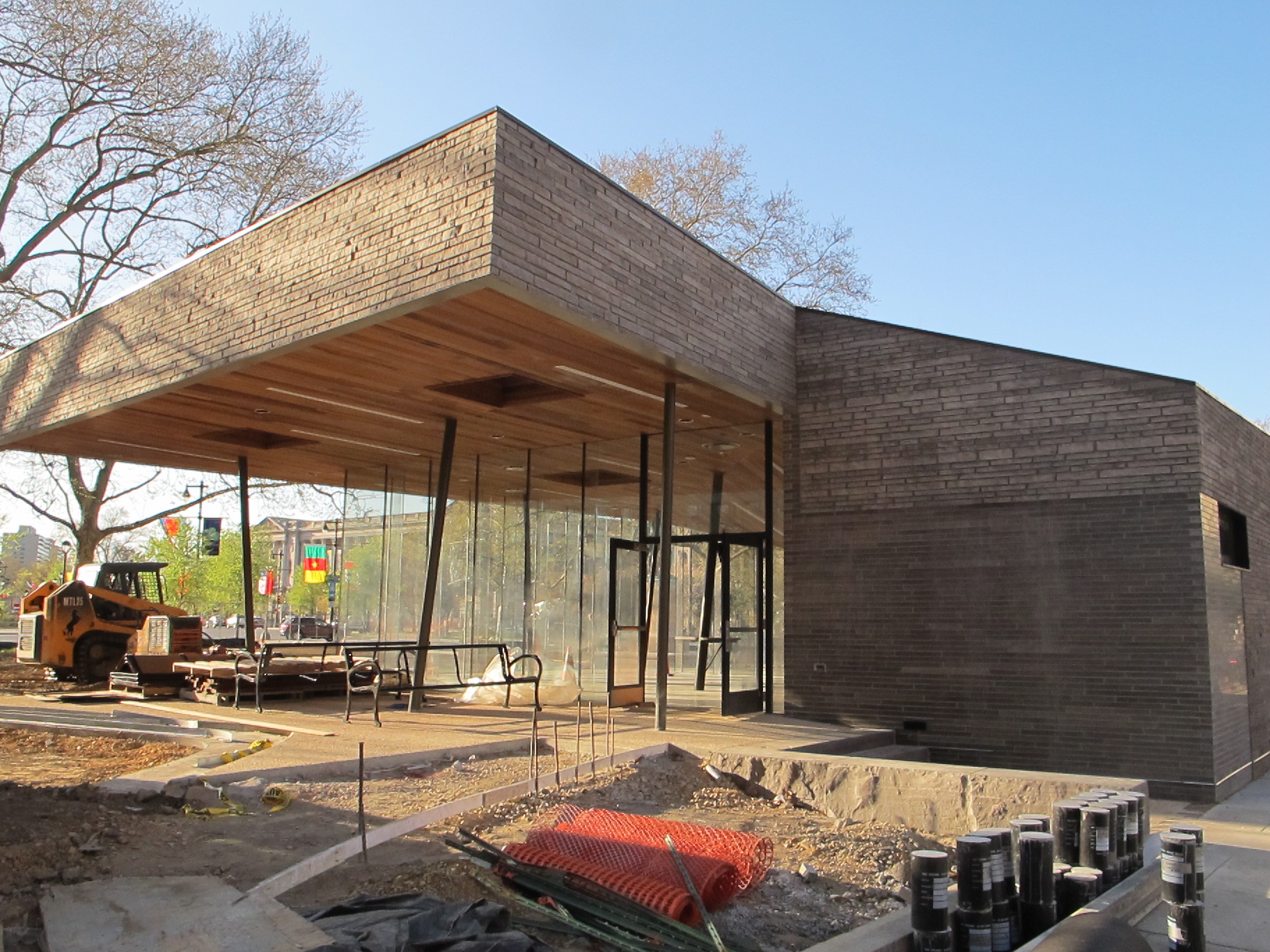Sister Cities Park: Logan Square’s new high-impact, playful park

You’d be forgiven for forgetting Logan Square’s old Sister Cities Plaza, but the new Sister Cities Park that replaces it is hard to miss. In an era of slim budgets, most public spaces are opting for ligher/quicker/cheaper improvements, but the new Sister Cities Park is brimming with major interventions.
On May 10, 2011 crews broke ground at Sister Cities Plaza and a year later to the day, this Thursday, Center City District and the City will open Sister Cities Park to the public. The new park is a playful take on the Parkway itself, connecting nature, urbanity, and culture.
Sister Cities Plaza was a stark bicentennial-era commemoration of Philadelphia’s 10 sister cities, set in an easterly remnant of Logan Square. These edges of Logan Square, like Aviator Park and Shakespeare Park are being reclaimed. But the transformation of Sister Cities is by far the most ambitious.
The new park’s design at the hands of landscape architects Studio Bryan Hanes and the architecture firm Digsau packs the space with activity through a fountain, pavilion, and children’s discovery garden.
I’ve been photographing construction since last summer and a few weeks back I was lucky enough to preview the park before the finishing touches were put on. Here’s what I saw then:
Sister Cities Fountain plaza:

At the park’s southern end is a garden surrounding Sister Cities Fountain, an abstracted globe with Philadelphia at its center. It’s a subtly formal, educational space where the names of our 10 sister cities are etched into the bluestone pavers making up the globe, and each city is represented by a jet of water proportional in scale to its distance from Philadelphia. The fountain’s jets are programmable, so they may be steady streams or jump across the fountain. The surrounding benches were made from granite salvaged from the old plaza.
You might be thinking that another fountain at Logan Square is overkill, but the scale is much smaller here. “The star of the show needs to be this,” Bryan Hanes told me, gesturing to Swann Fountain. He added that the materials, tones and textures at Sister Cities Park are distinctly deferential to Swann Fountain. And the site plan focuses much of the action toward 18th Street, while remaining oriented toward the Parkway.
Children’s Discovery Garden:

The design team wanted to bring elements of Fairmount Park onto the Parkway, and the discovery garden is meant evoke a child-sized Wissahickon. The rocky hill at the northern end – a surprising change in grade– has a trail, logs, and a stream winding its way down to the pool below. The plantings and decorative fence are also expicit nods to the flora and fauna of the Wissahickon.
After being inside the Academy of Natural Sciences or Franklin Institute for part of the day, the discovery garden is “about finding a way for kids to engage… get a little bit wet, a little bit dirty,” said Hanes. Kids can amble along the hill or push rented toy boats around in the pool.
Park Pavilion:

Bridging the formality of the Sister Cities Fountain plaza and the charmingly rustic children’s garden is an inviting, modern pavilion. Digsau’s Jules Dingle described the pavilion as a threshold space, designed to create a “seamless transition from city to garden.”
Dingle explained that the pavilion’s form deliberately echoes “rock forms that might loom overhead and create shelter” somewhere deep in the Wissahickon. The texture and tone of the pavilion’s natural materials soften the design’s sharp angles, and create a critical visual link in the park’s landscape. From inside, the glassy walls provide a 260° vista of Sister Cities Park, Swann Fountain, and the Parkway beyond.
The pavilion’s walls are clad with chocolaty blocks of Emerson (aka Eramosa) Limestone that is either buffed smooth, revealing striations that look like wood grain, or left rough. The ceiling is covered with cedar planks, which move from the building’s interior through the glass walls out onto the underside of the pavilion’s overhanging roofs. Over it all, a green roof pulls the plantings from the discovery garden up on top of the pavilion.
Beyond serving as a unifying design feature, the pavilion will house a Fairmount Park Visitor’s Center outpost and a café operated by Milk and Honey which will help underwrite the park’s upkeep by the Center City District.
Heavy Program:
For such a small area, it’s striking how heavily the new park is programmed. It’s a café! It’s a fountain! It’s a discovery garden and boat pond! It’s a small space, but all of this action is in service of a goal: To create activity and attract people to this part of the Parkway.
“We’re putting uses in there that draw people into the park,” Center City District President Paul Levy told me, contrasting Sister Cities with Aviator Park across the Square, which is more passive. People attract people. So if the area around a park lacks the density and foot traffic then the space can be activated by adding attractions within the park. Think Rittenhouse Square vs. Franklin Square.
The park’s program also makes Sister Cities feels like a place for all seasons. I can imagine putting my hands in the fountain on a hot day, or ducking into the pavilion for a coffee, to watch snow fall on the park in winter. The plan is to keep the park open 365 days a year from 6am-1am.
But is Sister Cities overdone? We’ll have to see how it feels when people start using the park.
“We’re walking a really fine line,” Bryan Hanes acknowledged. He told me this kind of heavy programming is atypical of his work, but the goal here is to attract people. “We’re trying to give this place a job.”
The ribbon will be cut at Sister Cities Park on Thursday at 1pm, and it will officially open Saturday May 12th – LOVE Your Park day – with a day full of family-friendly activities.
———
Pricetag: $4.6 million
Management: 30-year lease from the Philadelphia Department of Parks and Recreation to Center City District
Partners/Funders: Center City District, Department of Parks and Recreation, Pew Charitable Trusts, William Penn Foundation, John S. and James L. Knight Foundation, Pennsylvania Department of Community and Economic Development, State Redevelopment Assistance Capital Program, Pennsylvania Department of Transportation
WHYY is your source for fact-based, in-depth journalism and information. As a nonprofit organization, we rely on financial support from readers like you. Please give today.





